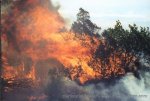Man I did not know this was going to be turned into a debate as to what caused this or the fire fighting techniques, I'll guess I'll have to go into detail here about what occurred at each site.
First if anybody has been around a military vehicle fully loaded you have to pay close attention to keep them from rolling on you.
1st the M211, we were ordered to go to the fire break to put out a spot fire that jumped the line, when we arrived on scene, I position the M211 on the flattest ground possible with the truck also pointed into our escape route just in case the fire started to advance quicker then anticipated. Once I got the truck positioned to were we can reach the fire plus pointed in the direction of our escape route. I set the parking, as far as the "Micro Brake" and please note that all the warning labels says quote "do not use the Micro Brake for Parking purposes" unquote. So I never use it or depended up on it because of that warning. So I grab the hose and chocks. I chocked the truck and advance down hill to battle the spot fire, we were there for 10 minutes battling the fire when the truck started to roll down the firebreak. We positioned the truck according to all NFPA rules; every situation is different even on the same fire. But since fire is dynamitic situations chance every minute, especially in Wyoming when wind will chance direction 3 times an hour. I thought I had the truck secured, but the constant rocking back and forth on the on the hand brake was too much for the M211 to handle, plus if the freaking chock did not get pushed in the sand the chock would of held the truck. I did not perceived the ground to be so soft. Also, if you look at the design of the parking brake on the M211, It's only designed to hold a vehicle on flat land. If anyone knows anything about converting our military truck to wildland fire trucks, one will find out very quickly that they are underpowered and under braked. Especially static braking. One brake shoe band around a single drum is not adequate braking, it will not hold back 28,000 pounds on an incline. This is why the county is getting out of the military truck business for wildland fire fighting.
Now for the M35- the driver set the hand brake, when he got out of the truck to give one of the guys down the hill a nozzle, he accidentally kicked off the hand brake while getting out. Everyone knows who drives an m35a2 that if you're not careful getting out of the cab, you can kick the handle off with your butt while getting out.
Again military vehicles by design makes the worse possible wild land fire trucks for as far as safety is concerned. Back to the m211, when I had a chance, which is 99% of the time I always butted the truck’s front or rear bumper against a tree, that way I knew it wasn't going anywhere. This time I did not have a chance to use a tree, I just had to depend upon the chocks and brakes available, which were inadequate for the current situation (ground was too soft and too much of an incline). So after these vehicle rolled, with every precaution available, plus some other western states too had vehicles roll on them, a rule came out stating that if you are in a M211, the driver will not get out under any condition, if you are driving any other type military vehicle the transfer case will be put in low and the transmission will be place in 1st gear and the engine off if the driver is going to leave the truck. Do not depend on the parking brake and chocks alone!
Our fire department at that time, half of our vehicles were military trucks, if you were the lucky ones and got there early you were able to grab on of the civilian type trucks. The people who came in later always got stuck with a military vehicle, me since I was one of the mechanics it seems I always got stuck with the M211. Nobody else wanted to drive it. I like military vehicles, I own a M211, but I hated them as a wildland fire truck just because of the situation. They were a pain to keep from rolling on you when fully loaded.
Now for qualifications, if you did not hold a red card you did not go to wildland fires. Also most of our members were FF1 or FF2 qualified. Everyone had to wear all the proper Nomax (yellow shirt and green pants, with a hard hat and shelter) We took our training serious, because we even fought fires on forest service property. Our equipment and training had to meet forest service requirements as they inspected our trucks and our training records before we went into a fire scene. If the truck failed the inspection or you were not trained to the point they felt necessary, you went home. We are not a bunch of hillbillies getting together drinking beer and calling ourselves a fire department as it is in some states.
So please stop replying that we didn’t know our vehicles or we did not know our responsibilities. That’s the furthest form the truth.




